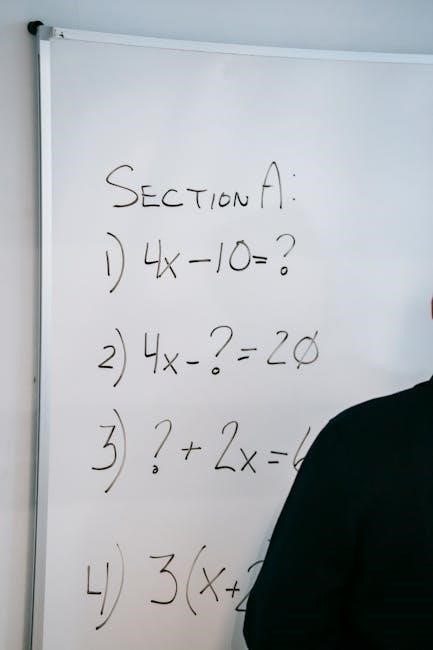Overview of the “Principles of Mathematics 10” Textbook
The Principles of Mathematics 10 textbook by McGraw-Hill Ryerson is designed for Grade 10 students, aligning with Ontario’s curriculum. It introduces topics in real-world contexts, with investigative activities and clear examples to enhance understanding. The textbook is available in print and digital formats, including PDF versions, making it accessible for modern learning. It focuses on building foundational math skills through interactive and structured lessons.
The McGraw-Hill Ryerson Edition of Principles of Mathematics 10 is a comprehensive resource designed for Grade 10 students in Ontario. Published by McGraw-Hill Ryerson, this textbook aligns with the Ontario curriculum, focusing on foundational math skills and real-world applications. It introduces concepts through investigative activities and clear examples, encouraging students to explore and understand mathematical ideas independently. The edition is available in both print and digital formats, including PDF versions, catering to diverse learning preferences. Its structured approach ensures students build a strong foundation in mathematics, preparing them for future academic challenges.
Key Features of the Grade 10 Mathematics Curriculum
The Grade 10 Mathematics curriculum, as outlined in the Principles of Mathematics 10 textbook by McGraw-Hill Ryerson, emphasizes foundational skills and real-world applications. It focuses on functions, geometry, trigonometry, and polynomials, with investigative activities encouraging student-led discovery. The curriculum promotes problem-solving, algebraic manipulation, and critical thinking. Key features include step-by-step examples, interactive exercises, and assessments aligned with Ontario standards. It also integrates technology, such as PDF resources, to support modern learning. The curriculum ensures students develop analytical and communication skills, preparing them for advanced math courses and practical applications in various fields. Its structured approach fosters a deep understanding of mathematical concepts, making it essential for academic success.
Structure and Organization of the Textbook
The Principles of Mathematics 10 textbook by McGraw-Hill Ryerson is logically structured to facilitate student learning. Each chapter begins with an overview and investigative activities, guiding students through new concepts. Clear sections and subheadings organize content, while examples and exercises provide practical application. The textbook includes a glossary, index, and appendices for quick reference. Digital versions, such as the PDF format, offer enhanced accessibility and portability. This organized approach ensures students can navigate topics seamlessly, from functions and geometry to trigonometry and polynomials, making it an effective tool for mastering Grade 10 mathematics. The design caters to diverse learning styles, promoting engagement and comprehension.

Core Topics Covered in the Textbook
The textbook covers essential math concepts, including functions, geometry, trigonometry, and polynomials. It emphasizes problem-solving, algebraic skills, and real-world applications, preparing students for advanced studies.
Functions and Their Properties
The textbook thoroughly explores functions, a fundamental concept in mathematics. Students learn about quadratic functions, their graphs, and transformations, as well as how to analyze and interpret their properties. The curriculum emphasizes understanding function notation, domain, and range, with practical examples to illustrate key ideas. Additionally, the text introduces polynomial, rational, logarithmic, and trigonometric functions, focusing on their behaviors, inverses, and applications. Investigative activities encourage students to discover relationships and develop problem-solving strategies. This section builds a strong foundation for advanced math, ensuring students can manipulate and apply functions to real-world problems effectively.
Geometry and Measurement

The Geometry and Measurement section of the textbook focuses on understanding spatial relationships and applying measurement concepts. Students explore properties of geometric shapes, including triangles, circles, and polygons, analyzing their perimeters, areas, and volumes. The curriculum emphasizes practical applications, such as calculating distances, areas, and volumes in real-world scenarios. Investigative activities encourage students to visualize and manipulate geometric figures, fostering problem-solving skills. Additionally, the section covers angles, trigonometry basics, and the Pythagorean theorem, providing a solid foundation for advanced geometric studies. Clear examples and step-by-step solutions help students grasp complex concepts, ensuring they can apply mathematical principles to various measurement and geometry challenges effectively.
Trigonometry and Its Applications
The trigonometry section introduces students to the relationships between angles and side lengths in triangles, focusing on right-angled triangles. Key concepts include sine, cosine, and tangent functions, with practical applications in solving problems involving heights, distances, and angles. Students explore how trigonometry is used in real-world fields such as physics, engineering, and geography. Investigative activities encourage the use of trigonometric ratios to model and analyze phenomena. Clear examples and step-by-step solutions help students master these essential skills, preparing them for advanced math and science courses. The section emphasizes problem-solving and critical thinking, ensuring students can apply trigonometric principles to various challenges effectively.
Polynomials and Rational Functions
The chapter on polynomials and rational functions focuses on understanding and manipulating polynomial expressions. Students learn to add, subtract, and multiply polynomials, as well as factor them to solve equations. The properties of polynomial functions, such as even and odd functions, are explored. Rational functions are introduced, emphasizing their graphs and asymptotic behavior. Investigative activities help students discover how polynomials model real-world phenomena, such as population growth and energy consumption. Clear examples and exercises guide students in mastering these concepts, preparing them for advanced algebra and calculus. The section bridges theoretical knowledge with practical applications, fostering problem-solving skills and mathematical reasoning.

Additional Resources and Study Materials
The textbook is supported by online PDF versions, teacher resources, and exercise workbooks. These materials provide interactive lessons, detailed solutions, and additional practice problems for comprehensive learning.
Online PDF Versions and Digital Accessibility
The Principles of Mathematics 10 textbook is available in digital formats, including PDF, offering students flexibility and convenience. The PDF version allows easy access on devices, reducing the need for physical copies. Digital tools enable features like search, highlighting, and note-taking, enhancing study efficiency. This format is particularly useful for students who prefer e-learning or need to access materials remotely. The digital version aligns with modern educational trends, ensuring accessibility and portability. It also supports environmentally conscious learning by reducing paper usage. McGraw-Hill Ryerson’s commitment to digital accessibility ensures that all students can engage with the curriculum in a way that suits their learning preferences. This resource is a valuable complement to traditional textbook learning.
Teacher’s Resource and Companion Materials
The Teacher’s Resource for Principles of Mathematics 10 by McGraw-Hill Ryerson is a comprehensive guide designed to support educators in delivering the curriculum effectively. It includes detailed lesson plans, assessment tools, and activity ideas to enhance classroom instruction. The resource aligns with the student textbook, ensuring a cohesive learning experience. Additionally, it provides tips for differentiating instruction and engaging students through interactive activities. This companion material is invaluable for teachers seeking to meet the diverse needs of their students while adhering to the Ontario curriculum standards. The resource is available in both print and digital formats, offering flexibility for educators to plan and deliver lessons efficiently. It is a key tool for fostering a dynamic and inclusive math learning environment.
Exercise and Workbook Companion
The Exercise and Workbook Companion for Principles of Mathematics 10 is a supplementary resource designed to reinforce learning and provide additional practice opportunities. It includes a wide range of exercises, each carefully aligned with the topics covered in the main textbook. The workbook offers step-by-step solutions to selected problems, helping students understand complex concepts and improve their problem-solving skills; Additionally, it contains review sections, quizzes, and cumulative assessments to ensure mastery of the material. The companion is available in both print and digital formats, making it accessible for all learning preferences. This resource is essential for students seeking to deepen their understanding and prepare for evaluations. It complements the textbook by providing hands-on practice, fostering confidence and fluency in mathematics.

Curriculum Alignment and Educational Standards
Principles of Mathematics 10 aligns with Ontario’s curriculum, focusing on developing essential math skills and problem-solving abilities. It meets provincial educational standards, ensuring comprehensive learning outcomes.
Alignment with Ontario Curriculum Requirements
The Principles of Mathematics 10 textbook is specifically designed to meet the Ontario Ministry of Education’s curriculum requirements for Grade 10 mathematics. It closely follows the academic standards set forth in the Ontario Curriculum, Grades 9 and 10: Mathematics (2005). The textbook ensures that students develop a deep understanding of mathematical concepts, including functions, geometry, trigonometry, and polynomials, all while fostering critical thinking and problem-solving skills. By aligning with provincial guidelines, the textbook prepares students for further academic success in mathematics and related fields. This alignment is crucial for maintaining educational consistency and achieving learning objectives across Ontario schools.

Skills and Knowledge Development in Mathematics
The Principles of Mathematics 10 textbook fosters essential mathematical skills, including critical thinking, problem-solving, and algebraic manipulation. Students develop a strong foundation in analyzing functions, understanding geometric relationships, and applying trigonometric principles; The curriculum emphasizes the ability to approach problems from multiple perspectives, promoting creativity and logical reasoning. By engaging with real-world applications, students gain practical insights into how mathematical concepts are used in everyday scenarios. This comprehensive approach ensures that learners not only master theoretical knowledge but also develop the confidence to apply it effectively in various contexts, preparing them for advanced studies and future career opportunities.
The Principles of Mathematics 10 textbook effectively provides a solid mathematical foundation, blending real-world applications with clear explanations. Its availability in PDF enhances accessibility, ensuring student success.
Importance of the Textbook for Student Success
The Principles of Mathematics 10 textbook is essential for student success as it aligns with Ontario curriculum standards, providing a comprehensive foundation in mathematical concepts. Its clear explanations, real-world applications, and interactive activities foster deep understanding. The availability of PDF versions ensures accessibility, catering to modern learning preferences. The textbook’s structured approach, combined with investigative tasks, helps students develop problem-solving skills and logical reasoning. By mastering the content, students build a strong mathematical foundation, preparing them for future academic challenges and fostering lifelong learning skills. This resource is indispensable for academic achievement in Grade 10 mathematics.
Future Applications of the Concepts Learned
The concepts explored in the Principles of Mathematics 10 textbook are foundational for future academic and professional pursuits. Students will apply these skills in advanced mathematics, science, engineering, and problem-solving scenarios. Understanding functions, geometry, and trigonometry prepares learners for careers in fields like architecture, physics, and computer science. The ability to analyze and interpret data, developed through these lessons, is crucial in emerging industries such as artificial intelligence and data analytics. Additionally, the logical reasoning and critical thinking cultivated in this course enhance overall academic performance and real-world decision-making. These skills are not only essential for higher education but also for navigating everyday challenges effectively.


0 Comments